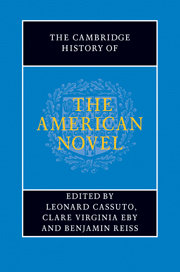Book contents
- Frontmatter
- General Introduction
- PART ONE INVENTING THE AMERICAN NOVEL
- Introduction: inventing the American novel
- 1 Transatlantic currents and the invention of the American novel
- 2 Susanna Rowson, Hannah Webster Foster, and the seduction novel in the early US
- 3 Charles Brockden Brown and the novels of the early republic
- 4 The novel in the antebellum book market
- 5 American land, American landscape, American novels
- 6 Cooper and the idea of the Indian
- 7 The nineteenth-century historical novel
- 8 Hawthorne and the aesthetics of American romance
- 9 Melville and the novel of the sea
- 10 Religion and the nineteenth-century American novel
- 11 Manhood and the early American novel
- 12 Sentimentalism
- 13 Supernatural novels
- 14 Imagining the South
- 15 Stowe, race, and the antebellum American novel
- 16 The early African American novel
- PART TWO REALISM, PROTEST, ACCOMMODATION
- PART THREE MODERNISM AND BEYOND
- PART FOUR CONTEMPORARY FORMATIONS
- A selected bibliography
- Index
16 - The early African American novel
from PART ONE - INVENTING THE AMERICAN NOVEL
Published online by Cambridge University Press: 28 July 2011
- Frontmatter
- General Introduction
- PART ONE INVENTING THE AMERICAN NOVEL
- Introduction: inventing the American novel
- 1 Transatlantic currents and the invention of the American novel
- 2 Susanna Rowson, Hannah Webster Foster, and the seduction novel in the early US
- 3 Charles Brockden Brown and the novels of the early republic
- 4 The novel in the antebellum book market
- 5 American land, American landscape, American novels
- 6 Cooper and the idea of the Indian
- 7 The nineteenth-century historical novel
- 8 Hawthorne and the aesthetics of American romance
- 9 Melville and the novel of the sea
- 10 Religion and the nineteenth-century American novel
- 11 Manhood and the early American novel
- 12 Sentimentalism
- 13 Supernatural novels
- 14 Imagining the South
- 15 Stowe, race, and the antebellum American novel
- 16 The early African American novel
- PART TWO REALISM, PROTEST, ACCOMMODATION
- PART THREE MODERNISM AND BEYOND
- PART FOUR CONTEMPORARY FORMATIONS
- A selected bibliography
- Index
Summary
For a long while, or at least up to the early 1980s, the history of the early African American novel could be told in fairly straightforward fashion. The first published novel by an African American writer, critics agreed, was William Wells Brown's Clotel; or, The President's Daughter (1853), which was followed by Frank J. Webb's The Garies and Their Friends(1857) and Martin R. Delany's serialized Blake; or, The Huts of America: A Tale of the Mississippi Valley, the Southern United States, and Cuba (1859, 1861-1862). Some critics also included Linda Brent's Incidents in the Life of a Slave Girl (1861) in their histories of the early African American novel. Rounding out that familiar group were the three revisions and reconceptualizations of Clotel that Brown published during the 1860s: the serialized Miralda; or, The Beautiful Quadroon. A Romance of American Slavery, Founded on Fact (1860-1861), Clotelle: A Tale of the Southern States (1864), and Clotelle; or, The Colored Heroine (1867). Then there was supposedly a gap in African American novelistic writing, a “nadir” of sorts, until the publication of Frances Harper's Iola Leroy; or, Shadows Uplifted(1892), which to some extent was inspired by Brown's portrayal of the “colored heroine” in his 1867 Clotelle.
A resurgence of interest in African American writing during the 1960s and 1970s inspired new scholarship that gradually revised and corrected this familiar narrative. In 1983, Henry Louis Gates, Jr., announced his “discovery” of the first novel by an African American woman, Harriet E. Wilson’s Our Nig; or, Sketches from the Life of a Free Black, which was published in 1859; and in 1987 Jean Fagan Yellin provided compelling evidence that Brent’s Incidents in the Life of a Slave Girl was actually an autobiographical narrative authored by the former slave Harriet Jacobs.
- Type
- Chapter
- Information
- The Cambridge History of the American Novel , pp. 267 - 282Publisher: Cambridge University PressPrint publication year: 2011
- 2
- Cited by



